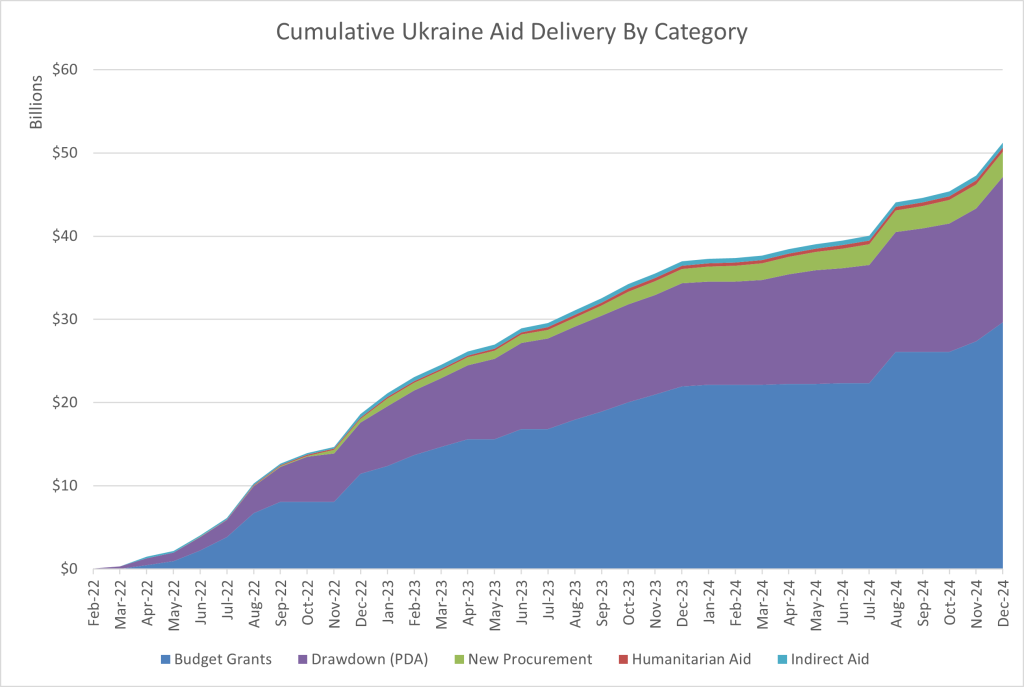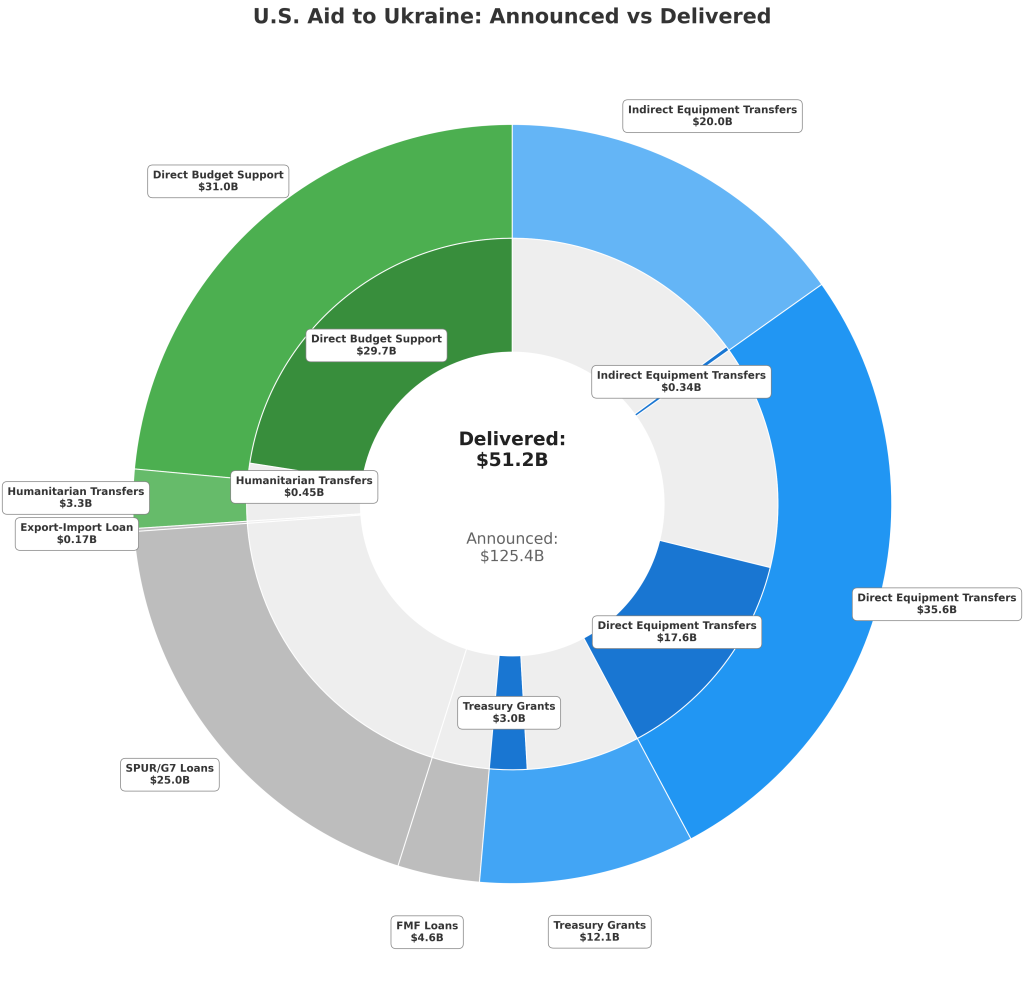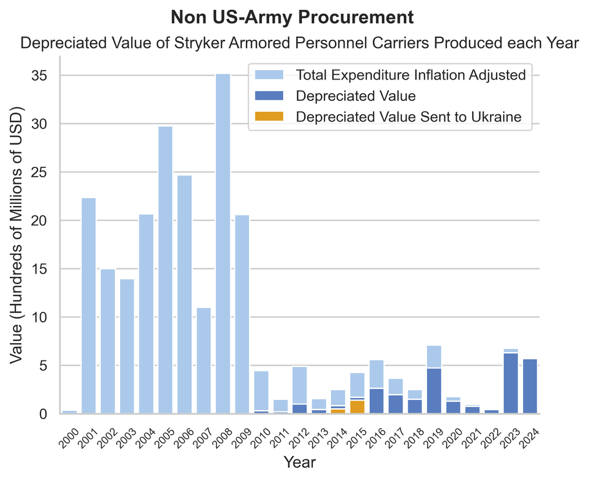
Comprehensively Valuing Ukraine Aid
An Economic Approach
Lead Authors: Anastassia Fedyk (UC Berkeley) and James Hodson (AI for Good Foundation)
Economists for Ukraine Research Council: Tatyana Deryugina (University of Illinois at Urbana-Champaign), Yuriy Gorodnichenko (UC Berkeley), Ilona Sologoub (VoxUkraine/KSE)
Research Coordinator: Emilia Marshall (UC Berkeley)
Data Aggregation and Analysis were carried out by a team of 19 Research Assistants at UC Berkeley, Stockholm School of Economics, and Minerva University.
All data for this analysis come from publicly available sources. The analysis will be updated on an ongoing basis as new data become available.
1. Overview
Since Russia’s unilateral annexation of Crimea and undeclared war in Ukraine’s East in 2014, the United States has been instrumental in providing Ukraine with training, equipment, and the institutional support needed to survive and develop as a democratic European nation.
Since 2022, due to Russia’s brutal and internationally condemned full-scale invasion of Ukraine, the United States stepped up and has been the single largest country-to-country provider of military and humanitarian aid to Ukraine, which has been critical to the functioning of government, the survival of civil society, and the ability of Ukraine’s military to hold back a much larger enemy.
However, the generally accepted understanding of United States aid to Ukraine does not correspond to reality, and this knowledge gap has been exploited to foster a growing rift and resentment between the allies.
We have performed an independent analysis based on publicly available data. Our findings show that in three years of full-scale war, the total monetary value of US aid delivered to Ukraine’s government amounts to $51.2 billion, of which $21.1 billion comprise military aid, and the remaining $30.2 billion is humanitarian aid and direct budget support in the form of expense reimbursement through the World Bank and collateral for loans. These figures—in particular, the military aid component—differ from the appropriation amounts by a factor of two to three. The US government has valued its military aid to Ukraine at $66.9 billion, whereas our estimate places it at $21.1 billion.
The discrepancy between the appropriation amounts and the values computed in our independent analysis stems from three main factors. First, the majority of US military aid to Ukraine has come in the form of existing equipment from US stockpiles. When we track every weapon provided and consider the vintage of these weapons, their full depreciation, and their failure rates (rendering equipment unusable by the US army), the value is at least 60% less. Second, where aid consisted of new equipment ordered, the US placed significant limitations on Ukraine’s choice of weapons and their use, and some of the equipment transfers have not yet occurred. Third, a substantial portion (approximately 25%) of the military aid was provided in the form of loans rather than grants. We discuss these factors in more detail in Section 3, after presenting some background information about US aid to Ukraine.

2. Background information on Ukraine aid
Most public-facing figures in the US government, the mainstream media, and even civil society institutions tend to discuss US aid to Ukraine since 2022 as if it were cash being sent to a foreign government. Generally available data tend to bundle together grants, loans, equipment, investments, and other forms of assistance as if it were all on-budget cash funding.
The reality of government support programs is more nuanced, but the first background fact is that the United States Government did not just transfer funds directly to the Government of Ukraine. Direct budgetary support for Ukraine has come either in loan form or in reimbursements administered by third parties such as the World Bank. As such, at no point in the past three years has the Ukrainian government been in a position to misappropriate United States funds.
The second background fact is that a substantial portion of United States’ aid to Ukraine has been in the form of military equipment, munitions, and related services. Under US law (Federal Assistance Act of 1961), the military units receiving the equipment have been extensively audited, and each piece of equipment has been verified on an ongoing basis to ensure it is not used in ways that were not intended. Every piece of equipment has been accounted for throughout this journey through extensive public and private reporting mechanisms.
The third fact is that Ukraine has been subject to extensive audits as an aid recipient, and there has been no evidence of issues or anomalies unearthed through those mechanisms. In fact, the level of corruption discovered in Ukraine linked to United States support is among the lowest of any country to which the United States has provided aid through the Federal Assistance Act.
The fourth fact is that the United States has provided less aid overall than Europe (EU + UK), and a comparable amount of military aid. The economies of Europe and the United States are comparable in size, so these allies have been similarly engaged in helping Ukraine.
3. Specifics on US aid to Ukraine that drive value discrepancies

Support from the United States for Ukraine can be split into the following categories: (a) direct funding via international institutional accounts (e.g. World Bank); (b) loans; (c) collateral for the issuance of loans to the Government of Ukraine; (d) Treasury Account Grants for US defense procurement; (e) direct equipment transfer under Presidential Drawdown Authority; (f) indirect equipment transfer by purchasing replacement equipment for an ally; (g) so-called “lend-lease” agreements (enacted but never used), and (h) Foreign Military Financing (FMF) accounts, which allowed strategic loans to Ukraine to purchase US defense supplies.
- (a) Direct Funding. The United States provided almost $31 billion via World Bank accounts managed by USAID contractors Deloitte and KPMG. A portion of those funds paid for the administration of funds and program audits, as well as overheads of the World Bank. These accounts work as a reimbursement for verified expenses for pensions, teachers’ salaries, healthcare workers’ salaries, and other critical social roles. Since Ukraine’s eGovernment system (Diia) is considered among the most advanced in the world, the Ukrainian government has effective documentation down to every individual disbursement into people’s bank accounts, electronic contracts, and digital receipts and procurement even for small supplies like pencils and paper cups. Furthermore, US budget support for Ukraine has frequently been conditioned on Ukraine implementing specific reforms.
- (b) Loans. The Export Import Bank of the United States made a loan to Ukraine worth $156M for the purchase of 40 diesel Wabtec locomotives, which supported 800 new jobs in Western Pennsylvania. The loan is repayable in full.
- (c) Collateral. The United States used its own funds and the interest earned on frozen Russian assets (a small minority of which are held in the US) to collateralize approximately $25 billion in loans for the recovery of Ukraine and Moldova. The loans were organized primarily through the World Bank in coordination with other stakeholders and are standard repayable debt instruments. Our analysis includes only the “value at risk,” the $1.6 billion that the US allocated to the World Bank to fund the grant under the Special Program for Ukraine and Moldova Recovery in our calculations. However, the U.S. does not incur any costs (beyond opportunity costs of funds) unless Ukraine defaults.
- (d) Treasury Accounts Grants. The US government provided $12.1 billion in procurement budget for US weapons systems, munitions, maintenance, and services needed by the Ukrainian military, mostly under the Ukraine Security Assistance Initiative (USAI) umbrella. This spending subsidizes and stimulates the US defense industry, helping maintain production at factories that may have otherwise shut down and shed jobs. Not all of the items procured have been delivered to Ukraine yet, and it is not clear how much of the $12.1 billion has been utilized. Based on available data on contracts and deliveries, we estimate that roughly $3 billion of value had been delivered to Ukraine via these procurement programs by December 2024, due to restrictions, delivery schedules, and the limited selection of items that Ukraine is allowed to procure.
- (e) Direct Equipment Transfers. Presidential Drawdown Authority (PDA) has been used 55 times in the last three years to send weapons and supplies directly from U.S. military stockpiles to Ukraine. Separately, a portion of FMF loan funding (see h) was converted to direct equipment funding when the Biden administration forgave $4.6 billion of its total value. The Department of Defense values the equipment sent under PDA at $31 billion, but this figure is based on the replacement cost, rather than the actual depreciated value of the weapons, the value in the market, or practical value on the battlefield. Using correct accounting practices, our deep analysis of every weapons system delivered to Ukraine, its age, the US stockpile status, and imputed battlefield failure rates gives a very different picture of the upper limit on the value of these systems to Ukraine: $17.7 billion. It should also be noted that the vast majority of the equipment provided to Ukraine is no longer used by the US military and therefore had an effective value of zero to the United States, other than as potential military support to allies, or as a liability due to stringent requirements for recycling of weapons systems and munitions. Our estimate of $17.7 billion is a conservative upper bound, as we do not fully write off such systems.
- (f) Indirect Equipment Transfers (“Backfill” via Third Countries). Multiple US programs have provided incentives to NATO partners to send older equipment and munitions to Ukraine (generally Soviet-era weapons, tanks, planes) in return for helping to accelerate defense modernization. The total incentive value from the US is around $20 billion across more than 40 countries since 2022, mostly in the form of loans with favorable terms. For example, the United States has provided about $2 billion of strategic Foreign Military Financing (FMF) loans into Poland’s defense industry, with only roughly $0.6 billion of that passing through to Ukraine in the form of U.S.-funded equipment. In this analysis, we account for the portion of support to NATO members that directly benefited Ukraine, screening out repayable obligations to the United States from allies.
- (g) Lend-Lease. The Lend-Lease program, enacted soon after the full-scale invasion in 2022, would have allowed the Administration to lend military equipment to Ukraine with deferred payment. However, all military aid was provided in the form of grants (drawdown or USAI) rather than loans. The program expired unused at the end of 2023, contributing $0 to our analysis.
- (h) Foreign Military Financing (FMF) Loans. The United States has allocated approximately $9.2 billion to loans for Ukraine and 17 other countries affected by the Russian war to procure American-made military supplies, services, and equipment. $4.6 billion was forgiven by the Biden Administration in 2024, and therefore the delivered portion is included in Direct Equipment Transfers, above.

With the above in mind, we would like to point out the following:
- Ukraine’s government is estimated to have received $51.2 billion in direct funding benefit from the United States government.
- All other sources of funding are either allocated to other countries (such as Poland) under the “Ukraine aid” umbrella or consist of debt, which Ukraine is already bound to repay and should not be included when referencing grant “aid.”
- No evidence of corruption has been identified from the mechanisms put in place to monitor and audit the use of funds and equipment by the government of Ukraine.
- The budgetary impact on the United States of supporting Ukraine has been negligible, at less than $17 billion per year—roughly the cost of maintenance and energy for federal buildings, or 0.25% of the federal budget in 2024.
US support to Ukraine has been critical to Ukraine’s ability to defend itself from Russia’s illegal invasion of a sovereign country. However, in the context of discussions regarding whether this support is too expensive for the US and the trade value of what the US has provided, it is important to place a precise valuation on the aid. We provide the figure of $51.2 billion as the first quantitative economic estimate of the value of US non-debt direct support to Ukraine.
About Economists for Ukraine
Economists for Ukraine is a non-partisan economic think-tank, part of the AI for Good Foundation, a US 501(c)(3) Public Charity whose mission is to promote economic and community resilience. The Economists for Ukraine network includes more than 400 economists representing the world’s leading academic, scientific, and economic institutions.